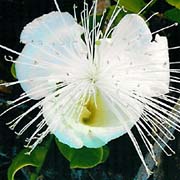
In the Garden![]()
Rick Barboza
Maiapilo
LATIN NAME
Caparis sandwichiana
WITH increasing rarity due to overdevelopment of its coastal habitat, the low numbers of maiapilo demonstrate the delicate balance of nature. The low numbers could in turn reduce the population of the native moth for lack of food and sustainable habitat, as these plants are likely pollinated by the moths that feed at night.
Description: Maiapilo is a small sprawling shrub with soft, light green leaves, fragrant white flowers and brittle stems. The large white flowers are extremely fragrant and look like a cross between a rose and an 'ohi'a lehua flower. These are night-blooming flowers, so by midmorning they are wilted.
During the evening, native moths pollinate the flowers when taking nectar. They are most likely attracted by the bright white reflection of the flowers in the moonlight and also by their lovely scent. Once the flowers are pollinated, small cucumberlike fruit, 3 to 5 inches in length, begins to develop. The fruit is filled with bright orange pulp and numerous small, brownish-black seeds.
Distribution: This rare endemic plant is found on the coast of all the main islands including some of the offshore islets and some of the Northwestern Hawaiian Islands. The plant pictured here is one of the last known plants on the eastern side of Oahu, where two plants grew side by side. The other fell victim to the recent construction of a walking path.
Cultural uses: This plant is related to capers, but there is no known cultural use for it at this time.
Landscape uses and care: This is an excellent plant for the xeriscape garden because it requires very little water once established in the ground. It is also an ideal plant for a "moon garden" because its big white flowers will shine and shimmer in the moonlight.
Be on guard for cabbage moth caterpillars that may munch on the leaves of this plant. Full sun and well-drained soil is best for this plant, and allowing the ground to dry out in between waterings is also a good idea.
Gardening Calendar


